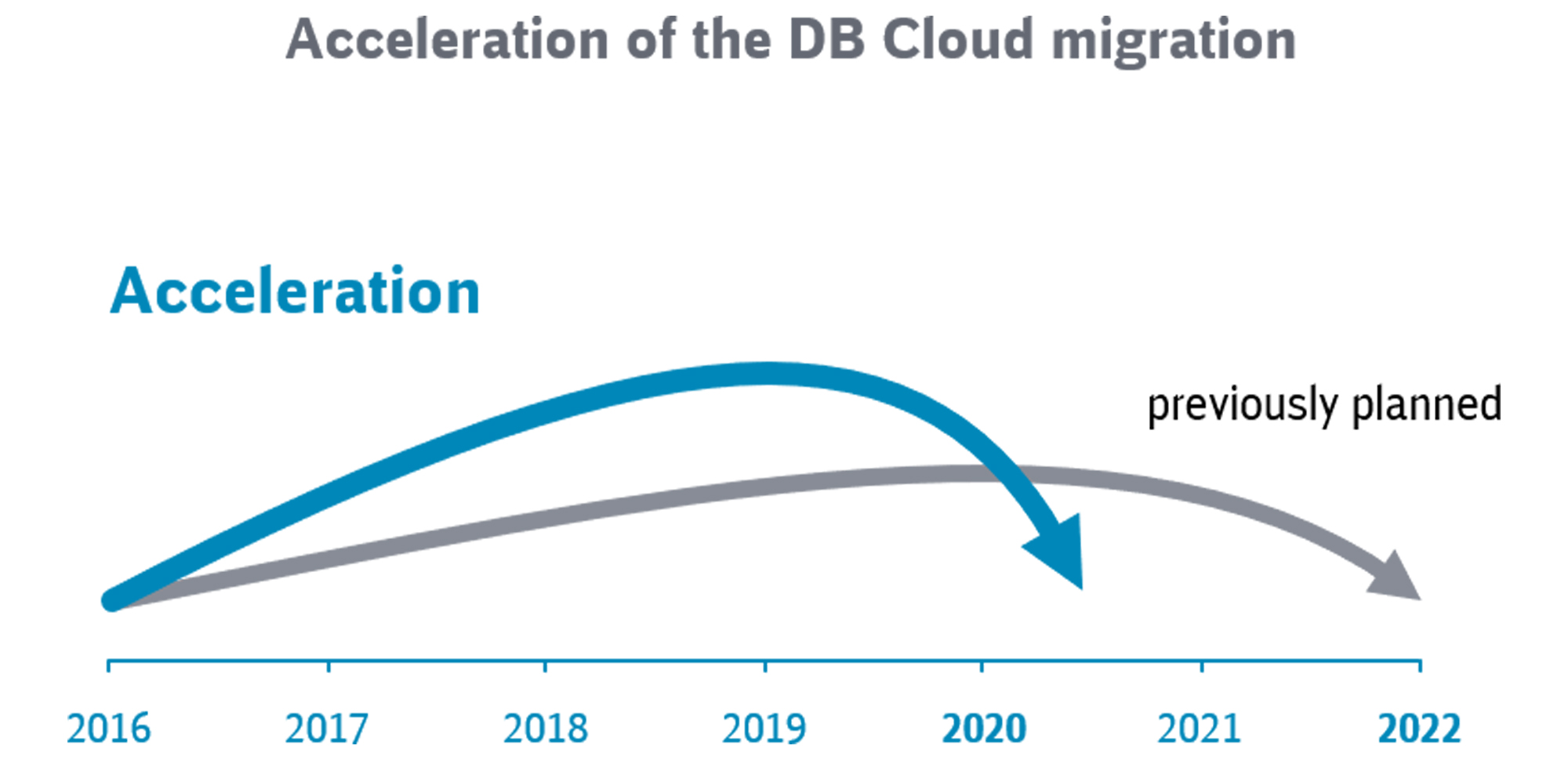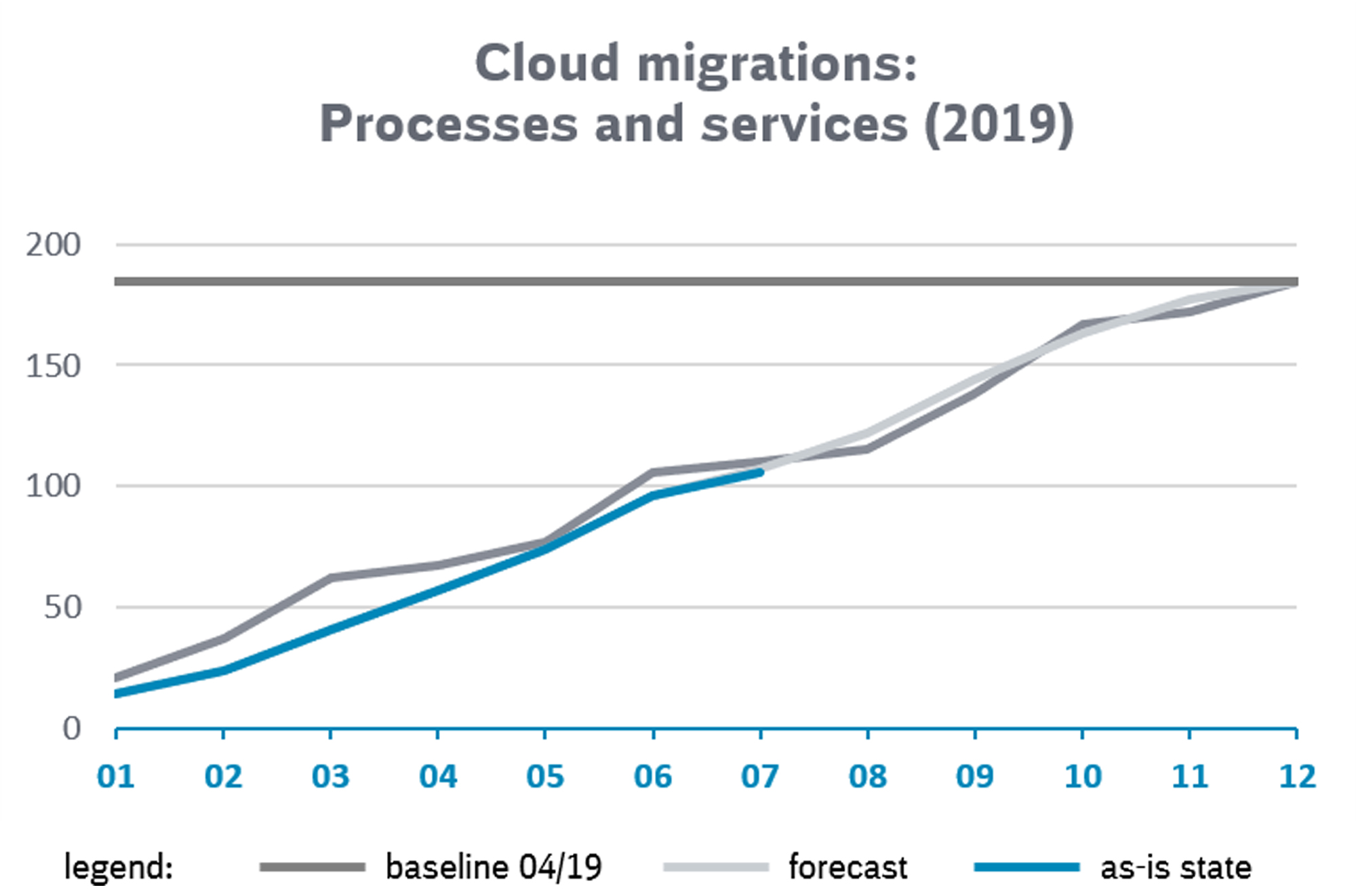DB Enterprise Cloud: A strategy becomes reality
Article: Rapid cloud migration – a preliminary assessment
09/2019 – For more than two years, the ShapeIT program has been ensuring implementation of the Deutsche Bahn cloud strategy, the central pillar for digitalization in the DB Group. In part, progress has been even faster than originally planned. It is time for a preliminary assessment.
Deutsche Bahn is setting a fast pace for the digitalization of the entire Group. A major success factor and also the technological foundation for the digitalization strategy is the establishment of a central cloud platform (DB Enterprise Cloud) for the development and operation of applications, products and services. For this reason, DB Systel started the implementation program ShapeIT in 2017 under Robert Arnhold, Program Director. ShapeIT creates the necessary framework conditions and requirements to achieve one primary goal: to make the advantages of DB Enterprise Cloud available to all users in the DB Group as quickly as possible, i.e. faster implementation of technical requirements, greater IT infrastructure performance, and greater flexibility in capacity management, and ultimately to lower costs.
The program encompasses far more than merely the creation of prerequisites or the migration of all applications, products and services into the DB Enterprise Cloud. It bundles all of the activities necessary for implementing a cloud-based production model from development to operation and also includes moving out of the DB data centre, which was sold as part of the cloud strategy.
The ShapeIT program also includes the use of cloud technologies for application development to drastically accelerate the time to market. Development will draw more heavily on the advantages of the cloud infrastructure and access preconfigured cloud services. Therefore, the ShapeIT program is also introducing DevOps as the new production model. DevOps models are being developed that fully breakdown the borders between development and operations – wherever this is possible. In comparison to the previous procedure, this represents a veritable quantum leap – not only for Deutsche Bahn: Currently, only few releases of applications can be issued per year in many locations. In the future, it will be possible, depending on the service and demand, to upload releases, updates or bug fixes up to twice a day if not even more often.
The effects are already apparent
The current objective is to achieve a complete migration, to the extent possible, of all applications, products and services into DB Enterprise Cloud – a process that is being executed during running operations. This affects approx. 80 percent of all applications, products and services that are operated by DB Systel. In addition, applications, products and services that are not cloud-capable are being migrated out of the data centre and will be operated using the services of an external IaaS provider. The cloud infrastructure and services are needed to make maximum rapid digitalization of Deutsche Bahn possible – while also optimizing the costs for application operation and infrastructure.
"Overall, migration into the cloud is well worth it for all applications. The business case refinances itself within three years."

The change to the cloud brings many advantages with it whose value can hardly be quantified. Without a cloud solution, for example, it would be necessary to provide computing capacities and security solutions such as redundancies to prevent failures. Due to the migration into the cloud, additional capacities are flexibly and directly available at all times. The scalability leads to better economy because IT resources only need to be paid for when actually used. By eliminating a separate data centre, costs for procurement, operation and maintenance of the IT infrastructure are reduced as well. “It is possible that individual applications might exist for which there are no cost advantages,” says Robert Arnhold, Program Director of ShapeIT. “But overall, migration into the cloud is well worth it for all applications. The business case refinances itself within three years.”
Driver behind continued development
At least as important as the economic advantages are the innovation potentials that result from the use of cloud services: Through direct access to the large and rapidly growing portfolio of services from the integrated cloud providers such as AWS or Azure, market innovations, based for example on the Internet of Things (IoT) and artificial intelligence (AI), will be easy to rapidly implement in the DB Group. The migration to the cloud also improves fault tolerance, data protection and data security. From very beginning, the technical experts in these fields and the associated committees were involved in the project. The conversion to cloud operation is also bringing with it changes in working procedure, roles and job profiles. For this reason, the ShapeIT program is offering all DB Systel employees comprehensive training and professional development opportunities as well as workplaces with a future. At the interfaces to the business units, these cultural changes will be jointly designed and will shape the culture in the DB Group going forward.
Cloud migration is progressing significantly faster than originally planned
The original time line had completion of cloud migration scheduled for 2022. “We assumed that we would have to spend a lot of time with conversion work,” says Robert Arnhold. “For this reason, we began early with the implementation.” The migration into the cloud is being implemented by ShapeIT project Cloud@DB under the direction of Dietmar Topp, who is responsible for the migration projects at DB Systel.
"Today we can say that the cloud migration program will be completed two years ahead of schedule."
Many milestones have already been crossed on the way to this point: By mid-2017, the proof of concept had been successfully performed and the first applications had been migrated. At the same time, activities surrounding the sale of the DB data centre were begun, which was sold in late 2017 and will be handed over to the new owner by the end of 2020. From the very beginning, teams were formed and trained for the migration and operation of the applications. Appropriate units were developed for the stable operation of processes in the cloud. In addition to Amazon Web Services (AWS), Microsoft Azure was selected and prepared as the second cloud provider and initial services could be successfully migrated. DevOps teams were formed at the same time.
At a glance
Milestones of the DB cloud migration (by mid-2019)
- 09/2016: Group decision for DB Enterprise Cloud
- 01/2017: Program start of ShapeIT
- 03/2017: Formation of the initial teams for migration and stable operation of processes in the cloud, migration of initial processes into the cloud
- 06/2017: Successful completion of proof of concept
- 12/2017: Sale of DB data centre
- 06/2019: Successful completion of the procurement of a second cloud provider and multiple non-cloud providers
Most of the work has been accomplished, together
Positive results have taken hold, such as a marked reduction in operating costs, which was passed onto the business units in the form of a price reduction. “This was the impetus for a huge amount of support from the business units, enabling us to revise our planning – with the goal of becoming faster overall,” says Robert Arnhold, naming one reason for the speed of implementation. “Today we can say that the cloud migration program will be completed two years ahead of schedule.” Cooperation between the business units has been highly effective, as is shown by the example of the DB Sales.
Next steps: By mid-2020, the remaining applications, products and services will have been migrated into the cloud or to an external IaaS provider. Moving out of the data centre will occur in parallel to the migration. Handover of the data centre will mark the end of the ShapeIT program. “Even if we have already put in a massive amount of effort and still have much to do, the implementation of a modern IT infrastructure and future-oriented production method is the foundation for rapid, far-reaching, cost-efficient and customer-oriented digitalization of Deutsche Bahn and therefore has no alternative,” summarizes Robert Arnhold and adds “It makes us, as Deutsche Bahn, a model for other corporations of this magnitude.”
Plans regarding DevOps provide for the identification and formation of further DevOps teams that will support an application end-to-end in the new production mode and implement customer requirements at a verifiably high rate. Supportive, market-conforming productivity tools and services, such as Continuous Delivery as a Service, PipeShip or Testautomation will be made available for this purpose. In addition to their deployment in DevOps teams, it will be examined where these tools can be implemented in running projects to deliver an added value for customers. Software that is developed and operated in this manner supports the continued development of the core business and thus promotes one thing in particular: more satisfaction among Deutsche Bahn customers.




